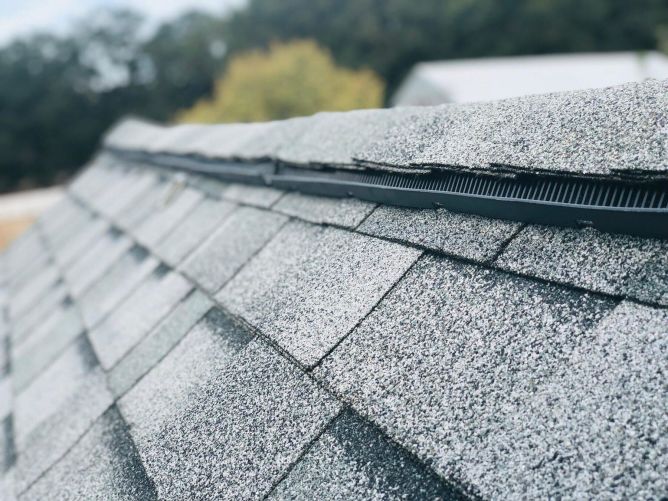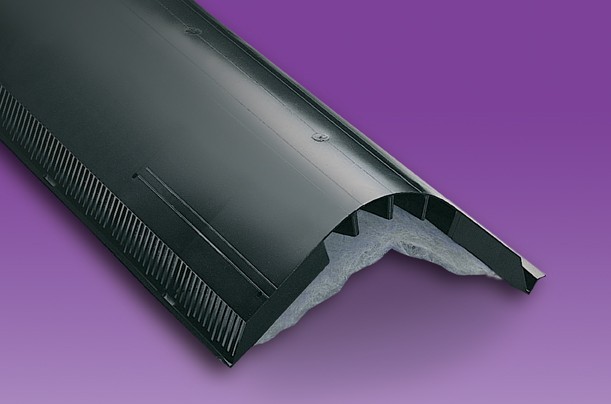Roof Replacement and Proper Attic Ventilation

When you think about roof replacement, you probably do not think of attic ventilation. After all, the major reason that most homeowners put insulation in their attic is to keep the heat in their house – allowing that heat to escape might, at first glance, seem counterproductive.
This could not be further from the truth! For example, in the winter, a well-ventilated roof helps to keep the attic cold – which is a good thing! A cold attic prevents ice damming where snow melts off the roof (because the attic is warm) only to re-freeze when it reaches the gutter, which is really cold. When the attic is at a similar temperature to the outside, this melting and refreezing either doesn’t happen or happens on a greatly reduced scale. On the other hand, in the summertime, proper attic ventilation will move hot air out of the attic. This will protect your roof from the excessive heat that can lead to premature aging and cracking of roof shingles – and in some cases, can even warp and crack the interior wooden framing.
It is crucially important when you are undergoing a roof replacement project to make sure that the roofing company you hire is installing the proper outtake ventilation – and examining your intake ventilation – needed for your attic to breathe. We will go over some more reasons why this is important below, as well as dispel some common myths and misconceptions about attic ventilation and roof replacement.
Intake and Outtake Ventilation
Before your roof replacement project starts, the roofing company you have chosen to work with should have went over a plan with you in regards to the type of outtake ventilation that will work best for your home. Most modern professional roof replacement companies use the superior ridge vent technology for outtake ventilation – however there are important exceptions where ridge vent is not sufficient, such as in hip roofs where the ridge is too small in proportion to the attic space. Here are some examples of outtake ventilation
• Ridge Vent – These vents are placed at the ridge of the roof, where both the roof planes meet at a peak. Ridge vents are the preferred modern solution to outtake ventilation, however there are still many applications where ridge vent is either not usable or not sufficient.
• Static, low profile, or turtle vents – These vents are non motorized and are usually installed near the roof ridge to allow air to flow from the attic. These types of vents used to be popular before ridge venting and architectural shingles became prevalent. These vents are still used widely in new construction homes because they cost less than ridge venting.
• Turbine Vent – A turbine vent draws air from inside the attic as winds turn the turbines. These types of vents are only recommended to be used in areas which have winds of at least 5 MPH on average. These tend to be the least reliable of all the outtake vent options.
• Powered Vent – A powered vent can be either electrical or solar powered. They are very similar too a roof mounted exhaust fan, however you can control it by a moisture monitor or a thermostat. Until the right temperature is reached, blades will spin within the unit. When it is reached, it will shut off. These types of vents are a great alternative to static vents and turbine vents in the case that a ridge vent can not be used.

It is also important for your roofing company to inspect your intake ventilation, as even the best outtake ventilation will not perform unless you have sufficient intake.
• Intake Vents – These are soffit vents and are one of the most popular kinds of vents that homeowners use. For one they are easy to install under the roofs overhang, they are hidden from view very well and also provide protecting from the elements outdoors.
• Edge Vent – If your roof style doesn’t allow for soffit type vents, these type of homeowners will usually get a drip edge vent. These are typically a two in one installation that promote water shedding. It is made of a resistant material that sticks out three inches from the roofs edge
• Gable Vents – This vent is normally a slotted section of wood or siding that is installed near the gable on the side of a home. Gable vents can function as both exhaust and intake. But they generally rely on strong winds. If the home is usually subject to wind driven rain, roofing professionals usually frown against getting a gable vent installed.
Increase the Lifespan of Your Roof and Shingles
If your attic gets overheated, your roof will be heated on its interior surface, in addition to the exterior one. This will cause the underlayment and then the shingles of your roof to dry out and crack much quicker than you’d expect, leading to expensive repair work.
• When you have proper ventilation, this helps moderates the temperature in the attic and in turn helps with the temperature in the rest of the house.
• Having proper ventilation helps with moisture build up in your attic. It can help prevent condensation problems in the winter that can often cause problems with the insulation and materials in the attic space.
• Preventing excess heat build up in your attic can provide energy efficiency in turn lowering your heating costs.
• It can help protect and extend the life of your roofing materials.
• It helps you with being up to date with most local building codes.will
Reduce or Prevent Ice Dam Formation
While they might look very picturesque, icicles hanging along the edges of the roof are not something a homeowner wants to see. They are a sign of Ice Damming, a problem commonly associated with a badly-ventilated attic. If your attic retains hot air rising from below and becomes too warm during winter, your roof will heat up. This will cause the snow on it to melt. The resulting water will flow down to the edge of the roof and gutter, where it’s considerably cooler, and refreeze, building up as the cycle is repeated with each new snowfall. In the end, water will back-up under the eaves and even into the attic.
Myths and Misconceptions About Attic Ventilation
As we outlined above, attic ventilation is one of the most important parts of a roofing system. A properly ventilated attic helps make sure air is properly circulated around your home. This reduces moisture and keeps indoor air fresh. Poor attic ventilation has previously been linked to health issues and home damage. Unfortunately, not many homeowners understand how attic ventilation works – so we are debunking some common myths below.
Myth 1: Roof Vents Offer Enough Ventilation
Not all roof vents are ideal for all homes. For example, ridge vents may be the most cost-effective type available. Still, without baffles that keep air out, they’ll provide little to no ventilation. Gable vents circulate air effectively, but only in their immediate area. Static, roof-line vents are adequate in terms of ventilation but generally have issues with leaks. Lastly, soffit vents may leave air trapped at the top of your attic. This might all sound very technical, but bottom line…
- There are various kinds of vents that work differently from one another.
- Installation can also affect the amount of air circulation.
- Roof vents’ efficiency varies in different roofs.
Effective ventilation systems make use of a “ride-and-soffit” continuous system. This design varies from roof to roof, so to get the best ventilation system for your home, turn to our professional team. We can inspect your current system and any inherent weaknesses that may be at work.
Myth 2: Vents are Only Needed in Hot Climates
Vents are needed in all climates for proper attic ventilation, energy efficiency, and preventing the build-up of moisture and condensation in the attic. While homes in hot climates, like Florida, see substantial benefits from properly ventilated attics, homes in all climates benefit from attic vents.
The truth: in colder seasons, homes need an unvented roofing system and insulation. These will prevent condensation and the moisture damage that follows. Proper ventilation is critical in the winter, especially with too much heat in the attic and cold snow on the roof. Preventing moisture damage is a much more significant benefit of attic ventilation.
Myth 3: The More Ventilation You Have, The Better
While insufficient attic ventilation can lead to moisture problems and decreased energy efficiency, too much ventilation can be just as bad. Attic vents add roof penetrations – essentially, more places where leaks can occur. Needlessly increasing the number of these penetrations will increase your risk of leaks and potentially cause blowouts during a hurricane.
Ideally, your attic ventilation balance would equal the size of your home, meaning your attic insulation has just the right amount of exhaust space to match the air intake. This will depend on the size and slope of your attic. Our roofing experts can help you determine the perfect amount of ventilation that your home system demands.
Myth 4: Attic Vents Remove Warm Air During The Winter
Common misconception! Heat does, in fact, rise into your attic then escapes through the vents. However, this happens when a roofing system has insufficient or degraded insulation that allows warm, moist air from your home to creep into your attic. This isn’t because the vents are removing the warm air; it’s because the insulation isn’t doing its job. At the end of the day, attic vents will not create a drag on your heating system, but you should make sure your attic insulation is doing its job!


